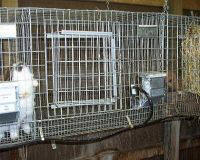By Laurie Stroupe
I found a week-old kit walking around on the ground this past week. Now before you say anything, I DO have baby saver wire for the first several inches around the bottom of my breeding cages. But every now and then, a kit still manages to get out.
 You may remember the story from long ago where a kit was going back and forth between two mothers, apparently with no problems. It would have been a problem for me except that it was a broken with a distinctive pattern.
You may remember the story from long ago where a kit was going back and forth between two mothers, apparently with no problems. It would have been a problem for me except that it was a broken with a distinctive pattern.
Last spring, I had two tiny kits to climb over the baby saver. One ended on the ground and died. The other went next door to an oatmeal box that I had put in the cage for the older kits to play in. Lucky for that tiny baby, the big kits liked to sleep in the oatmeal box. So the tiny kit was toasty and warm the next morning.
And just this week, I found a pile of kits between the baby saver wire and nest box. One was in the neighbor’s cage (thankfully, that mama rabbit and her two-month-olds didn’t seem to care). There was also one kit with his hindquarter in one cage and his front half in his own cage. It was hilarious to see. It confirmed one of my suspicions that sometimes kits climb on each other to get out (there were two kits under his front half). I also think they sometimes climb on their dam. Other times, I think they climb out of the nest box on the side, just above the level of the baby saver wire.
Use hardware cloth to keep kits where they belong.
Now you can put a stop to all of this by making cages with smaller openings. But the expense would be enormous. We have installed hardware cloth, which is much less expensive, over the regular cage wire on the couple of occasions we’ve noted a problem. I’d like to do them all that way, but it’s not high enough on my to-do list yet. I appreciate Pandora Allen sharing that tip with me. And one day, all of my breeding cages will have hardware cloth installed.
The hardware cloth, with its 1/2″ x 1/2″ grid, also prevents noses and ears from being nipped across the cage walls. It still might happen within a litter, but where there is just one bunny in a cage they would be safe from being molested by a neighbor.
Roxie recently cooperated with the pre-junior in the next cage to do some extensive barbering. She pressed her face against the cage and he (or she) obliged by removing all of the fur from it. Thank goodness she’s already granded. She’s a black doe and I could just see her fur growing back full of white spots (it didn’t, though).
My cages for show bunnies are made differently than my breeding cages. We built a gap between the compartments, which I use as a hay rack. In the winter, I can keep those racks stuffed with hay, which makes a solid barrier. In the summer, I like to just put a little hay in so as not to eliminate the air circulation they need to keep cool.
The gap prevents them from biting each other.
When the racks are fully stuffed, they prevent the rabbits from spraying each other, too. I love that design and would love to have another aisle full of them.
Another breeder told me the he has a gap that he places cardboard in. That prevents the bunny from rubbing in the urine he might spray on the cardboard.
I’m sure there are some other ideas for keeping baby bunnies where they belong and for keeping teeth and urine on the appropriate side of the cage wall. If you are planning to build some cages, take this issue into consideration. If you’ve already build or purchased cages, it’s not too late to modify them. [Editor’s note: You can buy plastic dividers to put between cages, or cut the sides and tops off of plastic containers.]
